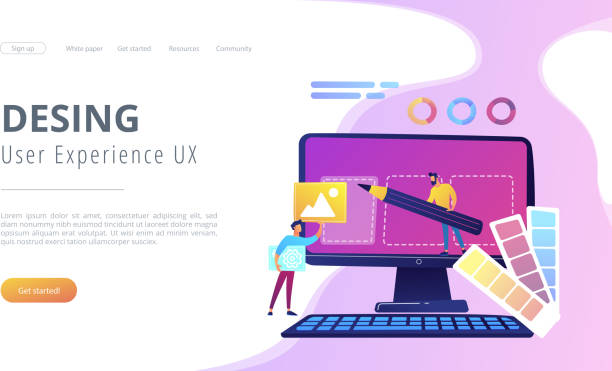Introduction to the Concept of Responsive Web Design and Its Importance

In today’s world, where #internet has become an inseparable part of daily life, users utilize a variety of devices to access web content.
From desktop computers and laptops with large screens to tablets and smartphones with different dimensions, user expectations for website user experience have also changed.
Amidst this, the concept of Responsive Web Design has emerged as a fundamental and vital solution.
This descriptive approach is not just a design technique, but a philosophy aimed at providing a seamless and optimal user experience, regardless of the size and type of device the user employs.
The importance of responsive design becomes evident when we consider how this approach can impact SEO, conversion rates, and overall user satisfaction.
With this educational approach, your website will be able to dynamically adjust its layout and elements to the user’s screen characteristics, including resolution, size, and orientation.
This means saying goodbye to the need for multiple versions of a website for different devices and focusing on a single codebase with unparalleled adaptability.
Are you disappointed with your online store’s low conversion rate?
Rasaweb, with professional e-commerce website design, is your definitive solution!
✅ Increase your sales and revenue
✅ Unparalleled user experience for your customers
⚡ Get a free consultation now!
The Evolution of Web Design and the Need for Responsiveness

The history of #web_design has been accompanied by many changes and developments.
Initially, websites were primarily designed for display on large monitors with fixed resolutions.
With the advent of #mobile_internet and the widespread use of smartphones in the 2000s, designers and developers faced a new challenge: how to display content in a way that is viewable and usable on small mobile screens? Initially, some websites offered separate “mobile” versions, usually with a different URL (e.g., m.example.com).
This news-worthy approach, while a temporary solution, brought several problems; including #repetition in development and maintenance, #SEO_issues due to duplicate content, and fragmented user experience.
The need for a more analytical and comprehensive solution was felt.
This evolution led to the emergence of the idea of responsive design, introduced by Ethan Marcotte in 2010.
This revolutionary idea, instead of creating separate versions, focused on designing a website that intelligently reacts to its user environment and provides the optimal display state.
This approach not only reduced maintenance burden but also significantly improved user experience and prepared the web for a future with diverse devices.
Fundamental Principles of Responsive Design: Fluid Grids, Flexible Images, and Media Queries

To understand how responsive design works, one must be familiar with its three fundamental principles: #Fluid_Grids, #Flexible_Images, and #Media_Queries.
Fluid grids, instead of using fixed pixel units, utilize relative units like percentages for the width of layout elements.
This means that the width of elements, rather than being fixed, changes with the screen size, and the website’s layout always optimizes available spaces.
Flexible images operate on the same logic; they are designed to be scalable with their container size, preventing overflow or overly large displays on small screens.
For this purpose, the max-width: 100% property in CSS is commonly used.
However, the backbone of responsive design is #Media_Queries.
This CSS3 feature allows developers to apply different styles based on specific device characteristics such as screen width, resolution, or device type.
For example, you can define that if the screen width is less than 768 pixels, fonts should become smaller or columns should stack vertically instead of side-by-side.
This specialized capability enables the creation of entirely different experiences for various devices, without the need to modify the HTML.
Below, a descriptive table is provided to compare these concepts, offering a deeper understanding of how they collaborate in responsive design.
These educational principles form the foundation of every modern and device-compatible website, and mastering them is essential for any web designer.
| Principle | Description | How to Implement |
|---|---|---|
| Fluid Grids | Using relative units (percentage, em, rem) for element dimensions, instead of fixed pixel units. | width: 50%; in CSS. |
| Flexible Images | Scaling images with their container size to prevent overflow or becoming too small. | img { max-width: 100%; height: auto; } in CSS. |
| Media Queries | Applying different styles based on device characteristics (screen width, resolution, orientation). | @media screen and (max-width: 768px) { ... in CSS. |
Numerous Benefits of Responsive Design for Users and Businesses

Responsive design has evolved beyond a mere trend into an industry standard, bringing significant benefits to both users and business owners.
From the user’s perspective, the most important advantage is a #better and seamless_user_experience.
Users no longer need to zoom in or scroll horizontally to view content on their mobile devices.
The website automatically displays in the best possible way, which leads to ease of use and greater satisfaction.
This directly impacts #customer_retention and user return rates.
For businesses, responsive design offers numerous strategic and operational advantages.
One of the most important is its #positive_impact_on_SEO (Search Engine Optimization).
Google prefers responsive websites and ranks them higher in search results, especially for mobile searches.
Having a single website instead of multiple versions also greatly simplifies management and maintenance, which means reduced costs and development time.
Furthermore, responsive websites have higher conversion rates because users have a better experience and face fewer obstacles in performing desired actions (such as purchasing, registering).
This analytical approach allows businesses, with a single investment, to reach a wide range of devices and audiences and to be leaders in today’s competitive market.
Ultimately, this design ensures that your website is also ready for the future and can adapt to new devices yet to be introduced.
Are you tired of your e-commerce website not generating as much revenue as its potential? Rasaweb, specializing in professional e-commerce website design, solves this problem forever!
✅ Increased sales rate and revenue
✅ High loading speed and unparalleled user experience
⚡ Get a free e-commerce website design consultation
Challenges and Important Considerations in Implementing Responsive Design

Despite its numerous benefits, implementing #responsive_design is not without challenges and requires specific considerations.
One of the most important concerns is #website_performance and loading speed.
If images or CSS/JS files are not optimized, the website might load slowly on mobile devices with slow internet.
This can lead to a poor user experience and an increased bounce rate.
Designers must carefully optimize content and resources for each breakpoint to prevent unnecessary loading of heavy resources for smaller devices.
Another challenge is #browser_compatibility.
Although modern browsers fully support responsive design features, incompatibilities may arise in older or less common browsers.
This necessitates thorough testing and sometimes the use of fallback solutions.
Furthermore, #content_strategy in responsive design must be carefully examined.
Should all content be displayed on all devices? Sometimes, for smaller devices, it’s necessary to prioritize or even remove certain visual or textual elements to maintain an optimal user experience.
This is a nuanced consideration that requires specialized decision-making.
Managing the complexity of CSS and JavaScript to ensure proper responsiveness across all dimensions is itself a specialized skill.
Developers must use appropriate tools and frameworks and write their code in an organized manner to minimize these challenges and deliver a responsive and efficient website.
Popular Tools and Frameworks in Responsive Design

To facilitate the #responsive_design process, numerous tools and frameworks have been developed that have greatly simplified the work for designers and developers.
These tools provide practical guidance and ready-to-use functionalities that accelerate development and improve compatibility assurance.
One of the most famous front-end frameworks is Bootstrap.
This framework includes a collection of HTML, CSS, and JavaScript, which can be used to quickly build responsive user interfaces.
Bootstrap, with its 12-column grid system and ready-made components, makes development much easier and is equally useful for educational and commercial projects.
In addition to Bootstrap, other frameworks like Foundation are also powerful options that provide tools for building fully customizable and responsive websites.
At a lower level, pure CSS technologies such as CSS Grid Layout and Flexbox have revolutionized how elements are arranged on web pages.
Flexbox is excellent for one-dimensional layouts (rows or columns) and Grid for two-dimensional layouts (rows and columns simultaneously), providing powerful tools for building complex and responsive designs without the need for heavy frameworks.
Using these tools in responsive design allows developers to work with greater efficiency and flexibility, ultimately creating websites that look and function excellently on any device.
Testing and Optimizing Responsive Design Across Different Devices

After implementing responsive design, the critical phase of testing and optimization begins.
Ensuring that the website functions correctly across all devices and screen sizes and provides a consistent user experience requires a precise and systematic testing process.
This specialized stage is the key to your website’s success in delivering a flawless experience.
#Browser_developer_tools (such as Chrome DevTools or Firefox Developer Tools) provide very powerful tools for simulating various devices and quickly testing responsiveness.
These tools allow you to change screen dimensions, simulate device types, and even simulate network conditions to assess website performance under different circumstances.
In addition, online #mobile_simulators and real device testing platforms exist that allow you to test your website on a range of actual or virtual devices.
This is essential to ensure compatibility across different browsers and operating systems.
#Performance_optimization is also a crucial part of this stage.
This includes image compression, CSS and JavaScript code optimization, and using lazy loading for images and videos to increase loading speed on mobile devices.
The ultimate goal is to provide a fast, smooth, and high-quality website on any device.
The table below lists some common tools and methods for testing and optimization to serve as practical guidance for you.
| Tool/Method Type | Description | Example/Use Case |
|---|---|---|
| Browser Developer Tools | Built-in browser tools for simulating devices, inspecting elements, and debugging. | Chrome DevTools, Firefox Developer Tools. Quick breakpoint testing. |
| Real/Virtual Device Testing Platforms | Cloud services for testing websites on a wide range of real or simulated devices. | BrowserStack, LambdaTest. Ensuring browser and OS compatibility. |
| Performance Optimization Tools | Tools for analyzing and improving website loading speed. | Google PageSpeed Insights, GTmetrix. Identifying and resolving performance bottlenecks. |
The Future of Responsive Design Beyond Screen Sizes

As technology rapidly advances, #responsive_design is also evolving, and its future will extend beyond mere adaptation to different screen sizes.
This analytical approach is moving towards creating more immersive and intelligent user experiences.
With the emergence of wearables, virtual reality (VR), augmented reality (AR), and even flexible displays, the concept of “responsiveness” will broaden.
The future website must be able to react not only to screen size but also to how the user interacts with the device, location, and even their personal preferences.
New technologies such as #CSS_Environment_Variables and advanced #CSS_Media_Features enable designers to create websites based on characteristics beyond width and height, such as ambient brightness, operating system dark or light mode, and even touch screen pressure.
Furthermore, artificial intelligence and machine learning can also play a significant role in future web design, where websites automatically adjust content and layout based on user behavior.
This news-worthy approach signifies the creation of “smart” websites that can offer highly personalized experiences.
Therefore, designers and developers must prepare themselves for these changes and continuously learn and update their knowledge to remain pioneers in this ever-changing world of the web.
Are you bothered by losing customers due to your e-commerce site’s outdated appearance or slow speed? Rasaweb’s expert team solves these problems with professional e-commerce website design!
✅ Increase customer trust and brand credibility
✅ Stunning speed and excellent user experience
Get a free consultation with Rasaweb now ⚡
Successful and Inspiring Examples of Responsive Web Design

To better understand the power and beauty of responsive web design, looking at #famous_brands and websites that have successfully implemented this approach is highly inspiring.
These engaging examples not only perform flawlessly across various devices but also provide an exceptional user experience, clearly demonstrating the benefits of this design philosophy.
Websites like GitHub, Apple, and Microsoft are prime examples of successful responsive design implementation.
These sites are meticulously optimized for display across various screen sizes; from large desktop displays to the smallest smartphones.
You can observe how, by resizing your browser window, page elements dynamically rearrange, images scale, and menus transform into a “hamburger” icon for easier access.
This flexibility ensures that users, regardless of their device, can easily access information and interact with content.
Furthermore, many large online publications like The New York Times or The Guardian also utilize responsive design.
This helps them deliver their news content in readable and accessible formats to millions of users across various devices.
Observing these #efficient_websites as illustrative examples can inspire designers to apply best practices to their own projects and create a truly universal web experience.
These examples prove that responsive design is not merely a choice but a necessity for success in the modern web landscape.
Practical Steps and Best Practices for Implementing Responsive Design

For any #web_developer or designer intending to implement responsive design, following a few practical steps and adhering to #best_practices is crucial.
This educational section provides the necessary guidance to start or improve your projects.
-
Mobile-First Design: This approach means starting the design for the smallest screen (usually mobile) and then expanding it towards larger screens (tablet and desktop).
This method ensures that the most important content and functionalities are available to mobile users and prevents the addition of unnecessary elements that could cause problems on smaller devices. -
Use Relative Units: Instead of fixed pixels, use relative units like
%,em,rem, andvw/vhfor widths, heights, fonts, and margins.
This allows elements to fluidly scale with the screen size. -
Image Management: Images must be #flexible (
max-width: 100%; height: auto;) and also optimized for different sizes.
Using the<picture>tag or thesrcsetattribute in the<img>tag allows you to load different images for various devices, which both improves loading speed and enhances the visual experience. -
Smart Use of Media Queries: Employ media queries to define key breakpoints where the website layout needs adjustment.
These points are typically determined based on content (Content-Out), rather than solely on standard device sizes (Device-In). -
Regular Testing: Throughout the #design_phase and development process, continuously test your website on various devices and browsers to ensure correct functionality and optimal user experience.
Utilize browser tools and online testing platforms. -
Performance Optimization: Always pay attention to website loading speed.
Code compression, image optimization, and using Caching can make a big difference in user experience, especially for mobile users.
By following these guidelines, you can create a responsive and efficient website that performs well on any device.
Frequently Asked Questions
| Question | Answer |
|---|---|
| What is responsive web design? | A method in web design where the website adapts to the screen size of various devices (desktop, tablet, mobile). |
| Why is responsive design important? | To provide an optimal user experience on any device the user employs and to improve SEO. |
| What are the main techniques of responsive design? | Using fluid grids, flexible images, and Media Queries. |
| What is a Media Query? | A CSS rule that allows applying different styles based on screen characteristics (such as width or height). |
| What are the benefits of responsive web design? | Increased user satisfaction, improved website ranking in search engines (SEO), reduced maintenance costs compared to having separate versions for each device. |
And other services of Rasaweb Advertising Agency in the field of advertising
Smart UI/UX: Transform sales growth by optimizing key pages.
Smart Direct Marketing: An effective tool for customer acquisition through Google Ads management.
Smart Digital Advertising: A novel service to increase click-through rates by optimizing key pages.
Smart Customer Journey Map: A quick and efficient solution to increase website visits by focusing on key page optimization.
Smart Website Development: A quick and efficient solution to increase website visits by focusing on attractive UI design.
And over a hundred other services in the areas of internet advertising, advertising consultation, and organizational solutions
Internet Advertising | Advertising Strategy | Advertorials
Sources
What is Responsive Web Design?
What is Responsive Web Design?
Responsive Web Design
CSS Responsive Web Design Tutorial
? With Rasaweb Afarin, the future of your business in the digital world is guaranteed! With our expertise in providing comprehensive digital marketing solutions, including corporate website design and advanced SEO strategies, we transform your online presence and accompany you on the path to sustainable growth and success.
📍 Tehran, Mirdamad Street, next to the Central Bank, South Kazeroon Alley, Ramin Alley, No. 6




